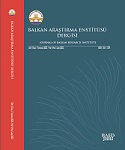XVII. YÜZYIL SONLARINDA KÖSTENDİL (ILICA), RADOMİR VE SİRİŞNİK KAZALARINDA İDARE, NÜFUS VE YERLEŞİM
ADMINISTRATION, POPULATION, AND SETTLEMENT IN KYUSTENDIL (ILICA), RADOMIR AND SIRISNIK TOWNSHIPS THROUGH THE END OF THE 17TH CENTURY
Author(s): Musa SezerSubject(s): Cultural history, Architecture, Local History / Microhistory, Social history, 16th Century, 17th Century, The Ottoman Empire
Published by: Trakya Üniversitesi Balkan Araştırma Enstitüsü
Keywords: Kyustendil; Radomir; Sirisnik; Avariz; Population;
Summary/Abstract: Kyustendil is a city in southwestern Bulgaria today. Bulgaria is located at the intersection of Serbia and Macedonia. Kyustendil was a Balkan city captured by Sultan Murad the First in 1372 without entering into war. Konstantin, who declared his allegiance to the Ottomans, ruled the location. Shortly after he died in 1395, the city became starboard of Rumelia. The 15th century was when Kyustendil started to gain its identity as a Turkish-Islamic city. Significant developments in architecture and public works took place in this century. This situation was influential in the city’s population growth as understood from the cadastral record books of the 15th century. By the end of the 16th century, the cadastral record books were replaced by the extraordinary tax record books. Although these record books do not provide as much descriptive data on the demographical and settlement characteristics as the cadastral record books for historical research, they give light to the present time in these areas by their various qualities such as exquisiteness and conciseness. In this study, the villages and neighborhoods connected to Kyustendil (Ilıca), Radomir, and Sirisnik counties under the Kyustendil Starboard in 1695 will be evaluated in terms of population-based on extra-ordinary tax record books. These record books will be compared with the book dated 1668, later found to be the previous extraordinary tax record book. Muslim and non-Muslim populations living in the neighborhoods and villages connected to the city center will be identified, and a comparative ratio will be specified between these two items. In this way, the religious structure of the population will be outlined. Civil and military people of residential areas will be identified and their rate in the city’s total population will be analyzed.
Journal: Balkan Araştırma Enstitüsü Dergisi -Trakya Üniversitesi
- Issue Year: 11/2022
- Issue No: 1
- Page Range: 169-205
- Page Count: 37
- Language: Turkish

